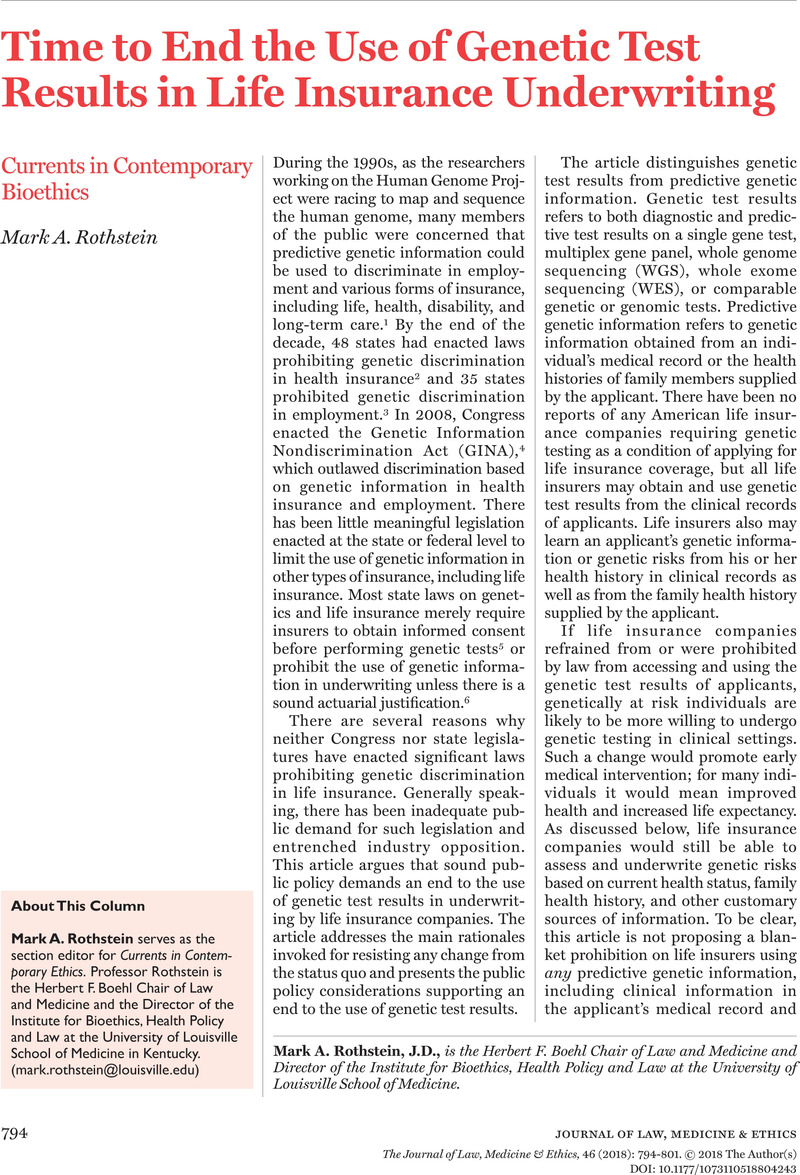Crossref Citations
This article has been cited by the following publications. This list is generated based on data provided by Crossref.
Mohan, Sumit
Iltis, Ana S.
Sawinski, Deirdre
and
DuBois, James M.
2019.
APOL1 Genetic Testing in Living Kidney Transplant Donors.
American Journal of Kidney Diseases,
Vol. 74,
Issue. 4,
p.
538.
2019.
Prohibiting Genetic Discrimination to Promote Science, Health, and Fairness.
The American Journal of Human Genetics,
Vol. 104,
Issue. 1,
p.
6.
Tiller, Jane
Morris, Susan
Rice, Toni
Barter, Krystal
Riaz, Moeen
Keogh, Louise
Delatycki, Martin B.
Otlowski, Margaret
and
Lacaze, Paul
2020.
Genetic discrimination by Australian insurance companies: a survey of consumer experiences.
European Journal of Human Genetics,
Vol. 28,
Issue. 1,
p.
108.
Joly, Yann
Dalpé, Gratien
Dupras, Charles
Bévière-Boyer, Bénédicte
de Paor, Aisling
Dove, Edward S.
Granados Moreno, Palmira
Ho, Calvin W. L.
Ho, Chih-Hsing
Ó Cathaoir, Katharina
Kato, Kazuto
Kim, Hannah
Song, Lingqiao
Minssen, Timo
Nicolás, Pilar
Otlowski, Margaret
Prince, Anya E. R.
P. S. Nair, Athira
Van Hoyweghen, Ine
Voigt, Torsten H.
Yamasaki, Chisato
and
Bombard, Yvonne
2020.
Establishing the International Genetic Discrimination Observatory.
Nature Genetics,
Vol. 52,
Issue. 5,
p.
466.
Golinghorst, Dexter R.
and
Prince, Anya E. R.
2020.
A survey of U. S. state insurance commissioners concerning genetic testing and life insurance: Redux at 27.
Journal of Genetic Counseling,
Vol. 29,
Issue. 6,
p.
928.
Frezal, Sylvestre
and
Barry, Laurence
2020.
Fairness in Uncertainty: Some Limits and Misinterpretations of Actuarial Fairness.
Journal of Business Ethics,
Vol. 167,
Issue. 1,
p.
127.
Rothstein, Mark A.
and
Brothers, Kyle B.
2020.
Banning Genetic Discrimination in Life Insurance — Time to Follow Florida’s Lead.
New England Journal of Medicine,
Vol. 383,
Issue. 22,
p.
2099.
Pugh, Jonathan
2021.
Genetic information, insurance and a pluralistic approach to justice.
Journal of Medical Ethics,
Vol. 47,
Issue. 7,
p.
473.
Ponomareva, D. V.
2021.
On the Issue of Discrimination Based on Genetic Status: Legal Approaches in the Judicial Practice of Foreign States.
Kutafin Law Review,
Vol. 8,
Issue. 1,
p.
129.
Tiller, Jane
and
Delatycki, Martin B
2021.
Genetic discrimination in life insurance: a human rights issue.
Journal of Medical Ethics,
Vol. 47,
Issue. 7,
p.
484.
2021.
Banning Genetic Discrimination in Life Insurance.
New England Journal of Medicine,
Vol. 384,
Issue. 9,
Primiero, Clare A.
Yanes, Tatiane
Finnane, Anna
Soyer, H. Peter
and
McInerney-Leo, Aideen M.
2021.
A Systematic Review on the Impact of Genetic Testing for Familial Melanoma II: Psychosocial Outcomes and Attitudes.
Dermatology,
Vol. 237,
Issue. 5,
p.
816.
Rothstein, Mark A.
2021.
Big Data, Surveillance Capitalism, and Precision Medicine: Challenges for Privacy.
Journal of Law, Medicine & Ethics,
Vol. 49,
Issue. 4,
p.
666.
Prince, Anya E. R.
Uhlmann, Wendy R.
Suter, Sonia M.
and
Scherer, Aaron M.
2021.
Genetic testing and insurance implications: Surveying the US general population about discrimination concerns and knowledge of the Genetic Information Nondiscrimination Act (GINA).
Risk Management and Insurance Review,
Vol. 24,
Issue. 4,
p.
341.
Tiller, Jane
Winship, Ingrid
Otlowski, Margaret FA
and
Lacaze, Paul A
2021.
Monitoring the genetic testing and life insurance moratorium in Australia: a national research project.
Medical Journal of Australia,
Vol. 214,
Issue. 4,
p.
157.
Primiero, Clare A.
Baker, Amy M.
Wallingford, Courtney K.
Maas, Ellie J.
Yanes, Tatiane
Fowles, Lindsay
Janda, Monika
Young, Mary-Anne
Nisselle, Amy
Terrill, Bronwyn
Lodge, Jason M.
Tiller, Jane M.
Lacaze, Paul
Andersen, Hayley
McErlean, Gemma
Turbitt, Erin
Soyer, H. Peter
and
McInerney-Leo, Aideen M.
2022.
Attitudes of Australian dermatologists on the use of genetic testing: A cross-sectional survey with a focus on melanoma.
Frontiers in Genetics,
Vol. 13,
Issue. ,
Karlsson Linnér, Richard
and
Koellinger, Philipp D.
2022.
Genetic risk scores in life insurance underwriting.
Journal of Health Economics,
Vol. 81,
Issue. ,
p.
102556.
Golinghorst, Dexter
de Paor, Aisling
Joly, Yann
Macdonald, Angus S.
Otlowski, Margaret
Peter, Richard
and
Prince, Anya E.R.
2022.
Anti-Selection & Genetic Testing in Insurance: An Interdisciplinary Perspective.
Journal of Law, Medicine & Ethics,
Vol. 50,
Issue. 1,
p.
139.
Glintić, Mirjana
2023.
Uporednopravni izazovi u savremenom pravu - In memoriam dr Stefan Andonović.
p.
553.
Nekoteneva, M. V.
and
Ponomareva, D. V.
2023.
Legal Regulation of Patenting the Results of Genomic Research at the Global, Regional and National Level.
Lex Genetica,
Vol. 2,
Issue. 1,
p.
61.



